What we’re looking at here is a pretty big topic, so we’re not going to cover absolutely everything. Want to know about the specific politics and society of Libya under Gaddafi? Gonna have to wait, but we’ll get to it. Whatever your thoughts on the man, whether a vicious tyrant, resolute revolutionary or something completely different, there’s no denying how damn fascinating he is. With his son campaigning for president and many loyalists still out there in the green strongholds of Libya, it definitely seems worth a rundown. So let’s get into it!
The Libyan Revolution
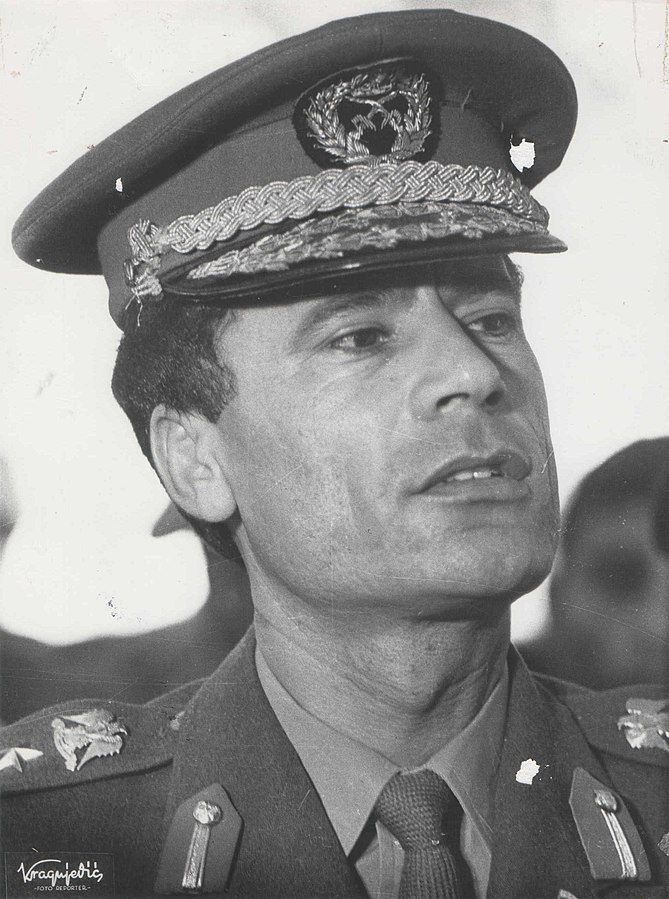
The 1st September revolution to be exact. Long before the 2011 revolution that ended his life, there was the 1969 revolution that brought him to power. Or… You know, the coup that brought him to power. While officially declared a revolution and with decent popular support, Gaddafi’s rise was strikingly similar to that of Nasser before him. The ‘Free Officer’s Movement’ who seemingly lifted inspiration directly from Nasser struck while Libyan king Idris was out of the country, seizing control of Benghazi within two hours and rapidly securing support for the rest of the military. In this era of popular pan-Arabism and resentment for the entrenched wealth of the monarchy, it wasn’t too uncommon an occurrence.
Libya was immediately placed under the administration of the ‘Libyan Revolutionary Command Council’, a twelve-person body with none other than Muammar Gaddafi at its head. The new era of Libya under Gaddafi had begun, with the first repressions beginning not long after. With the new government starting off shaky and another attempted counter-coup occurring within three months, Gaddafi swiftly began by purging monarchists and members of the king’s Senussi clan, seeing them as inherently untrustworthy. The press was rapidly censored and then taken directly under control, with trade unions banned by May of 1970.
Gaddafi soon used his newfound power to take care of ‘undesirables’. This was most notable with the ‘Day of Revenge’ announced the 21st of July 1971 as a deadline for the 7th of October when all Italians were required to leave the country. Leaving with them were most of Libya’s few remaining Jews, as Gaddafi announced that their property was to be seized and debts to Libyan Jews cancelled. The Day of Revenge later became a regular public holiday in Libya under Gaddafi.
Something that should be understood about this new Libyan government, which I’ve discussed in my Libyan flags article, is that the initial government wasn’t hugely interested in Libya itself. Not only was the manner of the coup similar to Nasser’s, the new national flag was the same one flown during the Egyptian coup. It wasn’t for a country specifically, it was a symbol of pan-Arabism. A belief that, because of how so many Arab states were the recent product of European meddling after WW1 and during colonialism, the old borders should be discarded and a pan-Arab nation established. This would be at the forefront of ideology in this period of Libya under Gaddafi.
Like many pan-Arab movements of this time, Libya espoused a particular kind of ‘Arab socialism’ that rejected Marxism and concepts of class struggle while embracing the likes of Islam. Still, it advocated a strong anti-imperialist platform and claimed to advocate ‘for the people’ while opposing at least certain aspects of capitalism. At this time, it was largely formless, without manifesto and simply following the tide of Nasser. Another key aspect of pan-Arab movements was support for the Non-Aligned Movement, which Libya had joined in 1964 and remained in under Gaddafi. The non-Aligned movement rejected alliance with the Soviet communist bloc and the capitalist American bloc. It’s in the name after all.
Early Libya Under Gaddafi
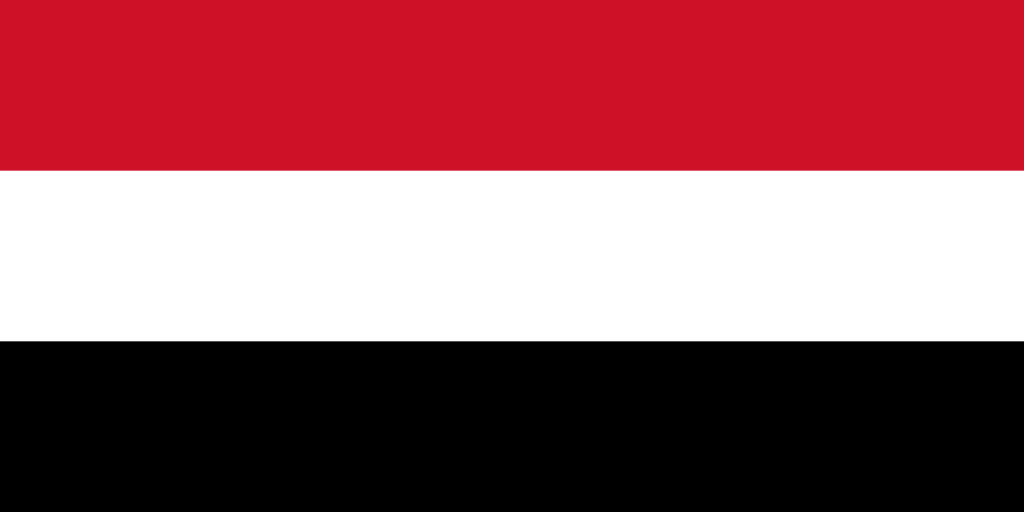
In 1973, Gaddafi finally began outlining the ideology of the new Libyan Arab Republic. On the 15th of April at Zwara, Gaddafi outlined ‘the five points for the continuation of the revolution. Firstly, to ‘abrogate all laws’, with the intent that new laws be developed as they’re needed. Gaddafi does explain that these are only the state laws, while Islamic law still holds people to account. Secondly, to purge the country of counter-revolutionaries. Thirdly, ‘freedom for the people’, announcing a desire to aid the majority of people and even to hand out guns to allied civilian militia and revolutionise the whole populace. Fourthly, the destruction of bureaucracy and fifthly, a desired ‘cultural revolution’.
So, a cultural revolution, huh? There was a significant other cultural revolution at this time over in China which it definitely tried to take influence from, albeit from a more Islamic and pan-Arab sense than a Marxist one. What’s interesting about this whole declaration is that it wasn’t known by any in the command council. Gaddafi had actually told them he’d announce his resignation at this massive public gathering and he completely turned it around, cementing his position more strongly than ever before while energising people to embrace his ideology. Soon, People’s Committees were being established across the country to enact Gaddafi’s vision of popular direct-democracy administration of both state and private businesses.
In September of 1974, the power of the committees was greatly reduced and Libya under Gaddafi returned to a certain normalcy, albeit with Gaddafi cemented much more strongly and with a pervasive cult of personality. With Libya now in a political union with Syria and Egypt, as well as flexing power by heading the 1973 US oil embargo, it was beginning to position itself as a titan of Africa. To step up the pace of development, Gaddafi announced Libya’s first five year plan in 1975, accompanied with the first publication of ‘The Green Book’, outlining Gaddafi’s vision for Libya. This book really needs its own article to outline Gaddafi’s ideals and intents for Libya.
Libya under Gaddafi had first defined itself by following in the shadow of Egypt, but with the passing of Nasser and the rise of Anwar Sadat who Gaddafi saw as a traitor. Relations collapsed in 1976 and by 1977, there was a short war between them. Only lasted a few days with a few hundred killed, but it decisively severed relations between the countries and established Gaddafi as the new head of the pan-Arab anti-America and anti-Israel movement. This break was marked with a major shift. Libya under Gaddafi was about to transform into the Jamahiriya.
The Jamahiriya
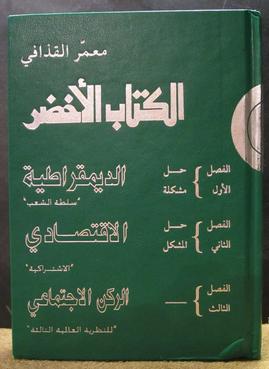
After letting the Green Book simmer in the background for two years, the break with Egypt gave Gaddafi the excuse to go all in. On March 2nd 1977, Gaddafi adopted the ‘Declaration on the Establishment of the Authority of the People’. Starting by reiterating loyalty to both ‘socialism’ and Islam, a list of new changes was outlined, beginning with the renaming of the country. Libya under Gaddafi was now known as the Socialist People’s Libyan Arab Jamahiriya. Jamahiriya, broadly defined to mean ‘state of the masses’ and can be considered a kind of people’s republic. Particularly notable was the statement that the ‘authority of the people’ would now be enacted through People’s Congresses. So what’s that all about?
How this system worked was that local areas had their own committees, the ‘Basic People’s Congresses’, around 1,500 across the country. Everyone of age was able to attend these and participate in civil administration with their votes and propositions. Each of these congresses elected members of a larger executive body, who in turn elected among themselves those to rise higher into the General People’s Congress, made up of 2,700 delegates. While in theory this was startlingly democratic, it ignores the fact that the ‘revolutionary council’ led by Gaddafi had absolute veto power and often decided on the highest positions of power personally.
Gaddafi claimed the following year to no longer exercise authority at all, but this was only in that he had no presence in the government structure besides this revolutionary council, which is where all the power was actually held. He claimed to not lead the country, but rather the revolution. A bit strange since his new official title was ‘Brotherly Leader and Guide of the Revolution’. Perhaps this lessened his grip on Libya’s economic policy, but most things that mattered were firmly under his control. This was still Libya under Gaddafi, not under the masses.
Revolutionary committees returned with a vengeance in 1977 as well, acting as pervasive informant networks that secretly policed the populace in staying true to Gaddafi’s vision. The economy too was greatly changed. Gaddafi more explicitly began denouncing capitalism and shifted from a mostly mixed economy to something akin to Tito’s Yugoslavian worker’s self-management socialism. There were wide-scale nationalisations and property ownership was limited to ‘one private dwelling’. Libya, at least in theory, was becoming more openly socialist, something made possible through massive profits from oil production that was used to subsidize many social programs.
Libya Under Gaddafi in the 80s
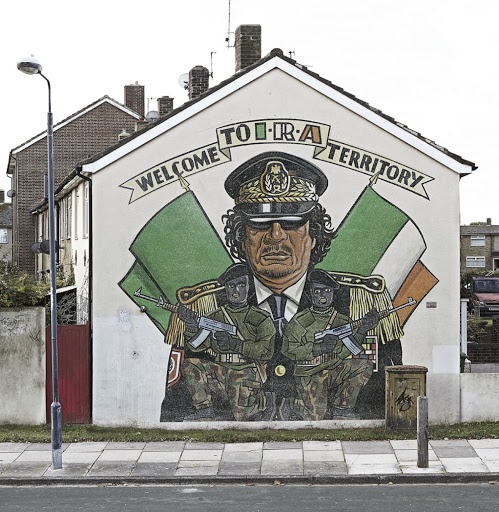
By 1980, the Jamahiriya system had been firmly implemented and Libya under Gaddafi had arguably peaked in terms of development. Relations with the rest of the world were at least still functional and oil remained a powerful commodity. In 1984, Gaddafi began the Great Man-Made River Project, an enormous irrigation plan throughout some of Libya’s most arid areas. It’s the largest irrigation project in the world to this day and covers 16,000 kilometres while supplying 70% of Libya’s fresh water. Gaddafi called it the 8th wonder of the world and it’s a genuinely incredible accomplishment. Alas, since Gaddafi’s death, much of it has since fallen into disrepair or been outright destroyed.
Relations with the west deteriorated rapidly through the 80s, particularly owing to Gaddafi’s habit of… Supporting foreign armed groups. From even the early 70s, Gaddafi had expressed and given direct support to groups like the Provisional IRA, but it hadn’t been on too large a scale. Millions were spent aiding the Sandinistas in Nicaragua, a whole five-tons of arms were intercepted on their way to the IRA, not counting that which actually arrived, the New People’s Army of the Philippines saw an ally in him, FARC in Colombia got some aid and even fringe British Trotskyist parties like the Worker’s Revolutionary Party got some sweet Libyan cash.
These are simply some of the examples. Dozens of armed groups and many more parties saw Libyan cash, even when their ideology had little at all to do with Gaddafi’s. In many cases, it was simply geopolitical, indirectly attacking enemies. Other times he seemed to be more interested in the ‘spirit’ shown, such as when funding for the IRA drastically increased after the 1981 Irish hunger strike. All of this could largely be tolerated. After all, most countries support foreign armed group, Libya was simply more… Invested than most. But things stepped up a lot when Libyans themselves started terrorist attacks abroad. That appeared a lot more rogue-statish.
Once incident in 1984 saw Libyan embassy staff in London respond to a protest outside by opening fire, wounding eleven and killing a police officer. Even for the usual wackiness of Libya under Gaddafi, this was a step too far and diplomatic relations were severed for a decade. A 1986 bombing of a German disco by alleged Libyan agents saw American airstrikes nearly kill Gaddafi and allegedly kill his daughter, along with many others. Gaddafi responded by adding the prefix ‘Great’ to the country’s official title while changing nothing. In 1988, the most infamous Libyan bombing occurred, the Pam Am Flight 103 over Lockerbie, was blown up, killing 270 people.
Libya Changes Once More
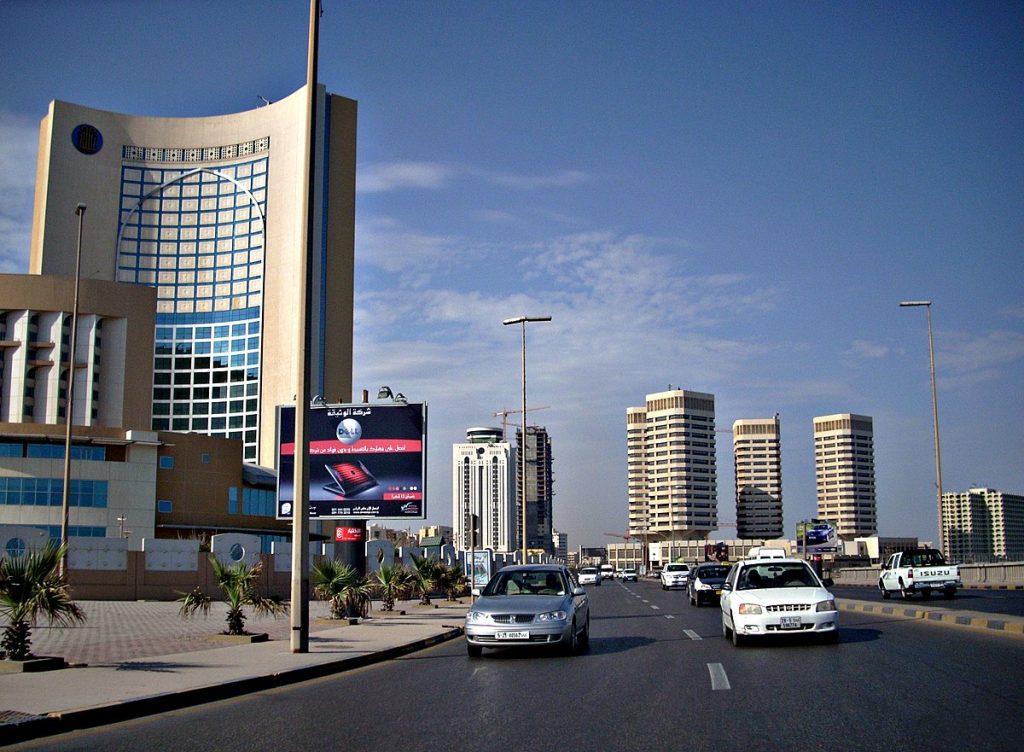
Libya under Gaddafi had changed a lot by the 1990s. The economy had lost its dynamism, plagued with inefficiencies and less buoyed by oil cash. Most crushing were 1992 UN sanctions after investigations around the Lockerbie plane bombing, which greatly severed Libya’s ability to interact with the rest of the world. The constant flood of arms abroad slowed to a trickle and Libya stepped back on the international stage. In response, Gaddafi seemed to change his approach. Rather than focusing all his efforts on the middle-east, he cast his eyes to Africa. One of Gaddafi’s most notable acts in the 90s was funding Nelson Mandela’s presidential campaign, leading to Mandela outright rejecting US calls to cut ties.
Oh yes, Libya under Gaddafi had changed. Gaddafi had changed too. His interests in pan-Arabism waned, shifting instead towards pan-Africanism. It was here that Gaddafi’s spending went into overdrive again, with many companies, schools, mosques, stadiums and more being funded throughout Africa and other parts of the world. These more egalitarian expenditures led to a massive surge in popularity for the internationally maligned figure in Africa. Even upon his death, the dominant reaction in Africa was one of grief in many nations. Gaddafi even expressed interest in bringing about a unified African currency to decouple the continent from the US dollar. Some have argued that this was a key factor in the US-led military overthrow of Gaddafi in 2011.
Moving into the 2000s, Gaddafi’s approach to the west had changed quite a lot too. The rhetoric had lessened, perhaps humbled by the tribulations of the 90s and a newfound perspective. In 2004, the EU dropped its sanctions the US took it off the ‘state sponsors of terrorism’ list in 2006, practically unthinkable from Gaddafi’s reputation in the 80s. Libya under Gaddafi seemed to be becoming a much more moderate state and while the world saw it most from the foreign policy, much the same was happening at home. The revolution was reforming and that ‘socialist’ economy was starting to unravel.
By 2004, Gaddafi had begun calling for wide-scale privatizations of the economy. Given Gaddafi’s conception of socialism was so loose already, it wasn’t hard to simply mask the actions with socialist-affirming language, but all the same it was clear that foreign companies were establishing themselves in a once unthinkable market. After a six-fold increase in foreign investment between 2003 and 2004, public demonstrations started breaking out, a situation that spooked some government hardliners into reversing course around 2006, though just barely able to slow it down. With the economy worsening, the state apparatus remained repressive, gradually building public resentment until its inevitable boiling point.
The 2011 Civil War
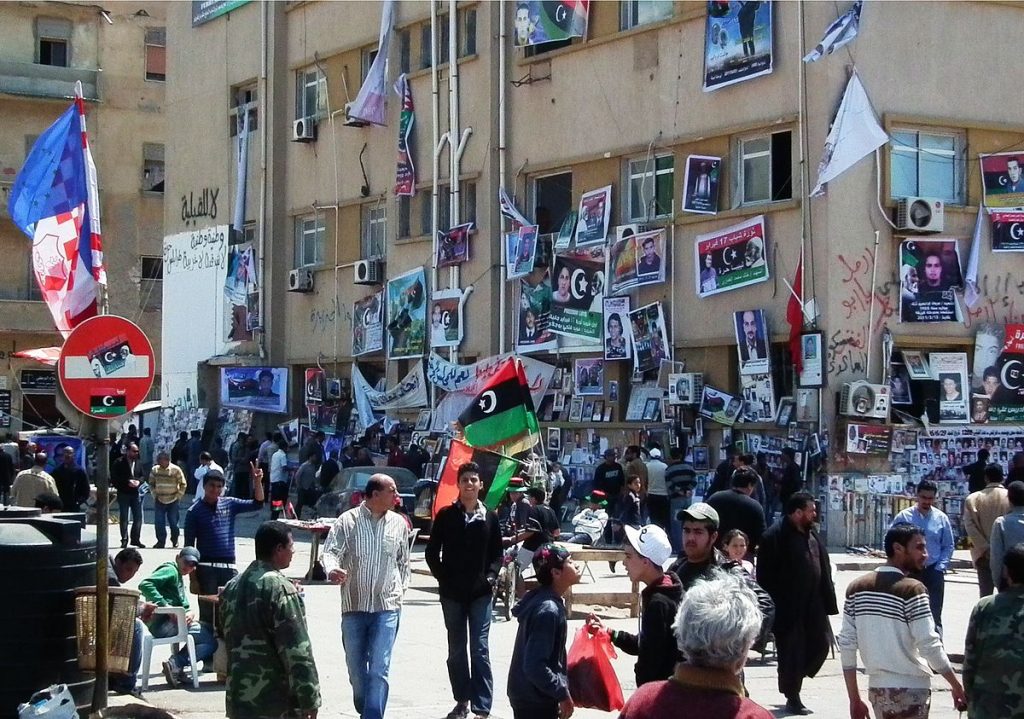
In January of 2011, the first small protests that would soon swell into uprising began. At first simple peaceful demonstrations for local issues, soon rising into demands for rights and then boiling over into riots. By February, police buildings were being burned down and the army was forced out of Benghazi by February 19th. Riding the sails of the wider Arab Spring of the time, the momentum was unstoppable and poorly fought against by a fundamentally crippled army. A National Transitional Council was formed later that month to consolidate a movement for the protest, drastically bolstering its status in the eyes of the international community. Libya under Gaddafi was now facing a revolution.
Gaddafi began wild accusations that protesters were from Al Qaeda, or all on drugs, or all drunk or just anything that would get them off his back. The military began a brutal crackdown that further fanned the flames of the protesters, allegedly opening fire at random even in these early days, with the harshness only intensifying as the revolution did. Even more unfortunate for Gaddafi was once the rebels realized these tales of horror grabbed international attention, even worse stories were falsified. Given there were genuine atrocities being committed and it was the middle of a war, it wasn’t easy to do an independent enquiry, so it simply became a ‘fact’ that Gaddafi’s authoritarian regime was now vastly worse.
Many of Gaddafi’s own allies simply found the crackdown a step too far and many key figures in the government stepped down or outright joined the rebels. Even worse still, military leaders and their soldiers started to defect too, crippling an already weakened army and giving countless weapons to the other rebels. Western nations soon joined in, funding and arming the rebels, then beginning air-raids themselves by mid-March. The situation deteriorated and Gaddafi announced his intentions to fight to the death. Which he very soon had to answer for as his convoy was bombed by NATO on October 20th. He was captured, tortured and shot in the head by the rebels, leading to the end of Libya under Gaddafi.





